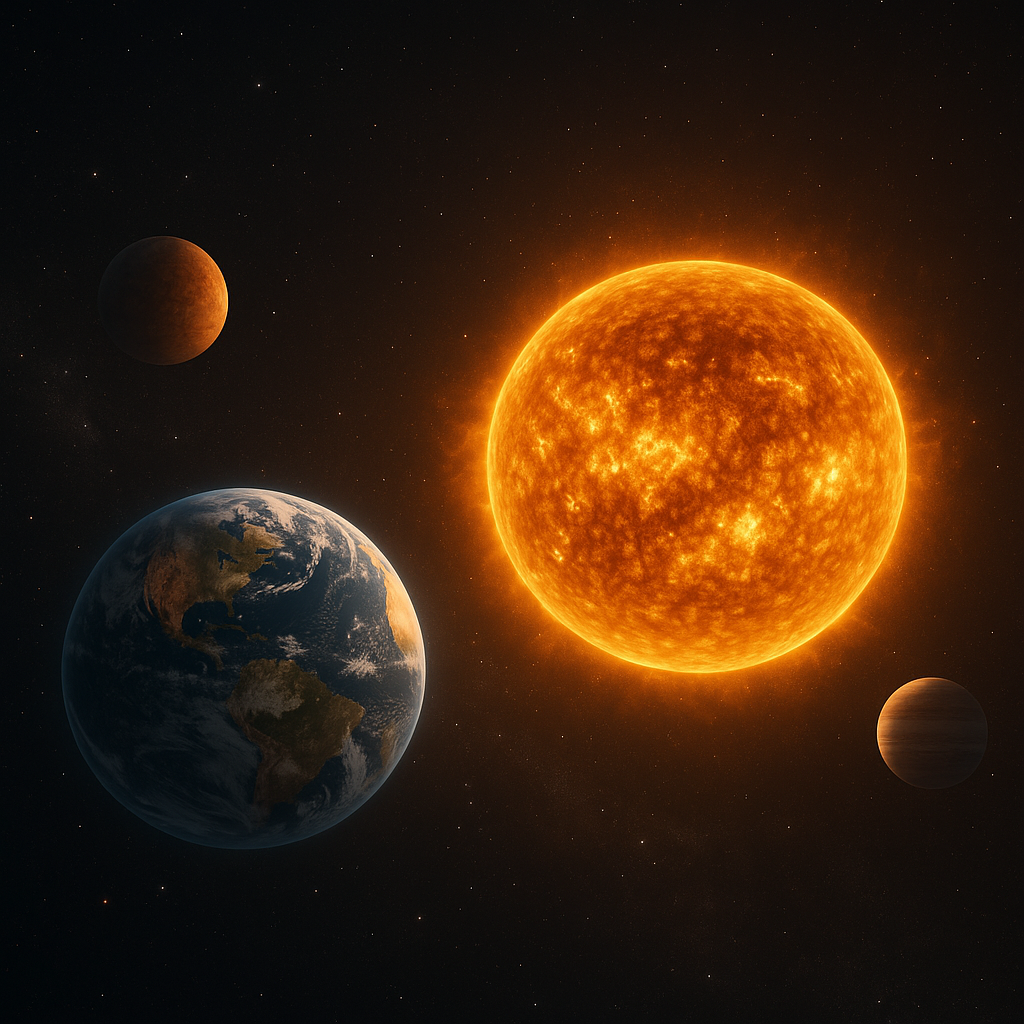⏲️ Estimated reading time: 6 min
The Sun is not just a bright disc in the sky but a nuclear giant 150 million km away, giving us light, heat, and life. Discover how fusion works, its structure, cycles, influence on Earth, magnetism, and its stellar future.
Why the Sun is Our Common Story
When we look at the Sun, we often reduce it to a familiar image: a glowing disc that rises and sets. In reality, it is a nuclear giant about 150 million kilometers away a vast distance, yet close in cosmic terms. Without the Sun, Earth would be a frozen rock, devoid of light, warmth, and life. Climate, seasons, winds, rains, photosynthesis, energy, and even human sleep cycles all are tied to the Sun.
The Sun contains more than 99% of the Solar System’s total mass. This immense weight creates gravity that keeps planets, moons, asteroids, and comets bound in orbit. It does not “burn” in the usual sense there is no oxygen there. Instead, it shines through nuclear fusion: hydrogen nuclei fuse into helium, releasing colossal amounts of energy. Every single second, the Sun releases more energy than humanity has used throughout its entire history.
This post is a complete, clear, and structured guide to the Sun: what it is made of, how it works, how it affects us, its cycles, and its eventual fate.
1) Distance, Scale, and the “Paradox of Familiarity”
- Astronomical Unit (AU): The average Earth–Sun distance is ~150 million km, known as 1 AU. Earth’s orbit is slightly elliptical, which explains minor seasonal variations.
- Size: Diameter ~1.39 million km (about 109 Earths across). Over 1.3 million Earths could fit inside if it were hollow.
- Paradox: We see the Sun daily, which makes it feel ordinary. Yet it is a typical G2V main-sequence star in a remarkably stable life stage.
2) Why the Sun Does Not “Burn” Like Fire
Fire requires oxygen. In the Sun, there is no combustion but nuclear fusion. At temperatures and pressures in the core, hydrogen nuclei collide and fuse into helium. The tiny loss of mass transforms into energy (E = mc²). That energy radiates outward, reaching Earth as sunlight ultraviolet, visible, infrared, and beyond.
3) The Sun’s Layers
Core (fusion zone)
~15 million °C; hydrogen fuses into helium here, generating energy.
Radiative Zone
Photons bounce endlessly, taking hundreds of thousands of years to escape.
Convective Zone
Hot plasma rises and cools, carrying energy to the surface by convection.
Photosphere
Visible “surface,” ~5,500–6,000 °C. Sunspots appear here.
Chromosphere
A reddish glow layer visible during eclipses.
Corona
Outer atmosphere, hotter than the surface (hundreds of thousands to millions °C). Still a mystery why.

4) Fusion: The Proton-Proton Chain
Most of the Sun’s energy comes from the proton–proton chain, fusing hydrogen into helium while releasing photons and neutrinos. These neutrinos pass through matter almost unhindered, billions streaming through your body each second proof of ongoing fusion.
5) Hydrostatic Balance: Why the Sun is Stable
The Sun is in hydrostatic equilibrium: inward gravity balances outward pressure from nuclear fusion. If fusion slows, gravity compresses the core, raising temperature and restoring fusion. If it speeds up, expansion cools it back down. This self-regulating cycle ensures long-term stability.
6) Magnetism, Sunspots, and Flares
The Sun is a magnetic dynamo:
- Sunspots: Cooler, darker regions with intense magnetic fields.
- Solar Flares: Sudden bursts of electromagnetic energy.
- Coronal Mass Ejections (CMEs): Massive plasma ejections that can cause geomagnetic storms on Earth, affecting satellites and power grids.
- Auroras: Stunning light shows triggered when solar particles interact with Earth’s magnetosphere.
7) The 11-Year Solar Cycle
The Sun’s activity rises and falls in ~11-year cycles, tracked by sunspot numbers. Solar maximum brings more flares and CMEs; solar minimum is calmer. This cycle is critical for space weather and satellite safety.
8) Solar Wind and Earth’s Shield
The solar wind is a constant stream of charged particles flowing outward. Earth’s magnetic field deflects most of it, forming the magnetosphere. Occasionally, strong storms bypass this shield, creating auroras and potentially disrupting modern technology.
9) How the Sun Shapes Life
- Climate & Seasons: Sunlight drives weather and atmospheric circulation.
- Photosynthesis: Plants convert solar energy into food and oxygen.
- Biological Rhythms: Sunlight regulates circadian cycles in animals and humans.
- Energy: Solar panels convert sunlight directly into electricity.
10) The Immense Scale of Solar Energy
In one second, the Sun releases more energy than humanity has consumed in its entire existence. Capturing even a fraction of the solar energy reaching Earth could power civilization many times over.
11) Observing the Sun Safely
Never look directly at the Sun without proper filters. Solar telescopes, space probes, and eclipse observations give us safe views of its surface and corona.
12) The Sun’s Future: Red Giant and White Dwarf
The Sun is ~4.6 billion years old, with about 5 billion years left in its main sequence phase.
- Red Giant Phase: The Sun will expand massively, possibly engulfing Mercury and Venus. Earth will be scorched.
- Helium Fusion: Briefly fusing helium into carbon and oxygen.
- Planetary Nebula: Outer layers expelled.
- White Dwarf: A dense stellar remnant, cooling slowly into darkness.

13) Cultural Importance
From Ra in Egypt to Helios in Greece and Surya in India, civilizations revered the Sun as a god. Today, science explains its workings, but its symbolic and practical importance remains timeless.
14) Fun Facts
- Sunlight takes ~8 minutes and 20 seconds to reach Earth.
- The Sun rotates faster at the equator (25 days) than at the poles (35 days).
- Over 1.3 million Earths could fit inside it.
- Its density is only slightly greater than water on average.
15) FAQs About the Sun
Q: Why does the Sun look yellow but appear white in space?
A: Earth’s atmosphere scatters blue light, leaving a yellowish tint. From space, sunlight is pure white.
Q: Could a solar flare harm humans on Earth?
A: Not directly Earth’s atmosphere and magnetic field protect us. But satellites, astronauts, and power systems can be affected.
Q: How much longer will the Sun shine?
A: About 5 billion years before it becomes a red giant and later a white dwarf.
Final Thoughts
The Sun is not an ordinary flame in the sky but a nuclear engine that powers life on Earth. It governs our climate, provides energy, regulates biological rhythms, and inspires culture. Stable yet dynamic, it stands as the heartbeat of our Solar System. Though its light will not last forever, its legacy will extend far beyond humanity teaching us humility and the importance of living within the fragile balance it sustains.
🔔 For more tutorials like this, consider subscribing to our blog.
📩 Do you have questions or suggestions? Leave a comment or contact us!
🏷️ Tags: Sun, Astronomy, Solar System, Nuclear Fusion, Solar Wind, Sunspots, Solar Flares, Solar Cycle, Red Giant, White Dwarf
📢 Hashtags: #Sun, #Astronomy, #SolarSystem, #NuclearFusion, #SolarWind, #Sunspots, #SolarFlares, #SolarCycle, #RedGiant, #WhiteDwarf
Only logged-in users can submit reports.
Discover more from HelpZone
Subscribe to get the latest posts sent to your email.

